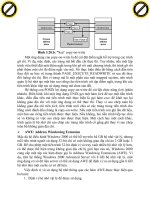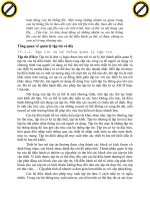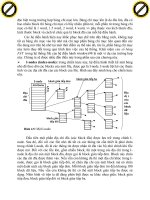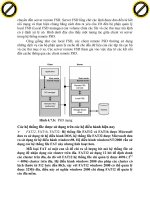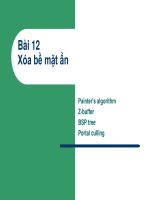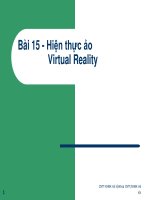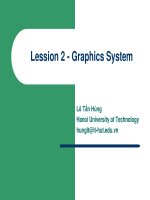Giáo trình thực tại ảo BKHN Ánh sáng – Light Kỹ thuật tạo bóng Render
Bạn đang xem bản rút gọn của tài liệu. Xem và tải ngay bản đầy đủ của tài liệu tại đây (1.15 MB, 70 trang )
Ánh sáng – Light
Kỹ thuật tạo bóng - Render
Lighting
So…given a 3-D triangle and a 3-D viewpoint,
we can set the right pixels
But what color should those pixels be?
If we’re attempting to create a realistic image,
we need to simulate the lighting of the surfaces
in the scene
– Fundamentally simulation of physics and optics
– As you’ll see, we use a lot of approximations (a.k.a
hacks) to do this simulation fast enough
Definitions
Illumination: the transport of energy (in
particular, the luminous flux of visible light) from
light sources to surfaces & points
– Note: includes direct and indirect illumination
Lighting: the process of computing the luminous
intensity (i.e., outgoing light) at a particular 3-D
point, usually on a surface
Shading: the process of assigning colors to
pixels
Definitions
Illumination models fall into two categories:
– Empirical: simple formulations that approximate
observed phenomenon
– Physically-based: models based on the actual
physics of light interacting with matter
We mostly use empirical models in interactive
graphics for simplicity
Increasingly, realistic graphics are using
physically-based models
Components of Illumination
Two components of illumination: light sources
and surface properties
Light sources (or emitters)
– Spectrum of emittance (i.e, color of the light)
– Geometric attributes
Position
Direction
Shape
– Directional attenuation
Lights
Infinitely distant point light
creates parallel rays
– Constant direction across field
of view
– No radiant energy drop-off
Local light sources
– 1/R
2
energy drop-off
– Radial directions from source
– Even more complex if the
source is distributed rather
than point-like
Components of Illumination
Surface properties
– Reflectance spectrum (i.e., color of the surface)
– Geometric attributes
Position
Orientation
Micro-structure
Common simplifications in interactive graphics
– Only direct illumination from emitters to surfaces
– Simplify geometry of emitters to trivial cases
Ambient Light Sources
Objects not directly lit are typically still visible
– E.g., the ceiling in this room, undersides of desks
This is the result of indirect illumination from
emitters, bouncing off intermediate surfaces
Too expensive to calculate (in real time), so we
use a hack called an ambient light source
– No spatial or directional characteristics; illuminates all
surfaces equally
– Amount reflected depends on surface properties
Ambient Light Sources
For each sampled wavelength, the ambient light
reflected from a surface depends on
– The surface properties
– The intensity of the ambient light source (constant for
all points on all surfaces )
I
reflected
= k
ambient
I
ambient
Ambient Light Sources
A scene lit only with an ambient light source:
Directional Light Sources
For a directional light source we make the
simplifying assumption that all rays of light from
the source are parallel
– As if the source is infinitely far away
from the surfaces in the scene
– A good approximation to sunlight
The direction from a surface to the light source is
important in lighting the surface
With a directional light source, this direction is
constant for all surfaces in the scene
Directional Light Sources
The same scene lit with a directional and an
ambient light source (animated gif)
Point Light Sources
A point light source emits light equally in all
directions from a single point
The direction to the light from a point on a
surface thus differs for different points:
– So we need to calculate a
normalized vector to the light
source for every point we light:
lp
lp
d
Point Light Sources
Using an ambient and
a point light source:
How can we tell the
difference between a
point light source and
a directional light
source on a sphere?
Other Light Sources
Spotlights are point sources whose intensity falls
off directionally.
– Supported by OpenGL
Area light sources define a 2-D emissive surface
(usually a disc or polygon)
– Good example: fluorescent light panels
– Capable of generating soft shadows (why?)
The Physics of Reflection
Ideal diffuse reflection
– An ideal diffuse reflector, at the microscopic level,
is a very rough surface (real-world example: chalk)
– Because of these microscopic variations, an
incoming ray of light is equally likely to be reflected
in any direction over the hemisphere:
– What does the reflected intensity depend on?
Lambert’s Cosine Law
Ideal diffuse surfaces reflect according to
Lambert’s cosine law:
The energy reflected by a small portion of a surface
from a light source in a given direction is proportional
to the cosine of the angle between that direction and
the surface normal
These are often called Lambertian surfaces
Note that the reflected intensity is independent of
the viewing direction, but does depend on the
surface orientation with regard to the light source
Lambert’s Law
Computing Diffuse Reflection
The angle between the surface normal and the
incoming light is the angle of incidence:
I
diffuse
= k
d
I
light
cos
In practice we use vector arithmetic:
I
diffuse
= k
d
I
light
(n • l)
n l
Diffuse Lighting Examples
We need only consider angles from 0° to 90°
(Why?)
A Lambertian sphere seen at several different
lighting angles:
An animated gif
Specular Reflection
Shiny surfaces exhibit specular reflection
– Polished metal
– Glossy car finish
A light shining on a specular surface causes a
bright spot known as a specular highlight
Where these highlights appear is a function of
the viewer’s position, so specular reflectance is
view-dependent
The Physics of Reflection
At the microscopic level a specular reflecting
surface is very smooth
Thus rays of light are likely to bounce off the
microgeometry in a mirror-like fashion
The smoother the surface, the closer it becomes
to a perfect mirror
– Polishing metal example (draw it)
The Optics of Reflection
Reflection follows Snell’s Laws:
– The incoming ray and reflected ray lie in a plane with
the surface normal
– The angle that the reflected ray forms with the surface
normal equals the angle formed by the incoming ray
and the surface normal:
l
=
r
Non-Ideal Specular Reflectance
Snell’s law applies to perfect mirror-like
surfaces, but aside from mirrors (and chrome)
few surfaces exhibit perfect specularity
How can we capture the “softer” reflections of
surface that are glossy rather than mirror-like?
One option: model the microgeometry of the
surface and explicitly bounce rays off of it
Or…
Non-Ideal Specular Reflectance: An
Empirical Approximation
In general, we expect most reflected light to
travel in direction predicted by Snell’s Law
But because of microscopic surface variations,
some light may be reflected in a direction slightly
off the ideal reflected ray
As the angle from the ideal reflected ray
increases, we expect less light to be reflected

